| |
"When they show us an England, it seems to have been taken from a few issues of The Sketch and Tatler and a collection of Christmas cards. Only the faintest dribble of real English life is allowed to trickle into most of our films." |
| |
J.B. Priestley, 1939 |
| |
"Fifty years on from now, Britain will be still be the country of long shadows on cricket grounds, warm beer, invincible green suburbs, dog lovers and pool fillers, and, as George Orwell said, 'Old maids bicycling to Holy Communion through the morning mist'." |
| |
John Major, 1993 |
When Nobel Laureate Doris Lessing declined John Major's offer of the title 'Dame Commander of the British Empire' in 1992, she politely pointed out that there was no longer an Empire left to speak of. She repeated that remark soon after at a public event I had the honour of chairing, adding that the idea of being called 'Dame Doris' seemed as preposterous as it was pompous, not least because it would have made her sound like a pantomime horse. The audience responded to her comments with unanimous murmured approval and to her joke with sustained gleeful laughter. It felt as though all present were revelling in a shared recognition that the emperor has neither clothes nor empire. In my mind that evening came to symbolise a clash of civilizations, between an outdated, decadent establishment and a vivacious, irreverent citizenry. I thought of that delightful democratic moment as I watched Portrait of a People. Loss of empire is the subtext that informs this collection, containing 14 films made by the Central Office of Information between 1949 and 1970.
Portrait of a People is the fifth volume in a series of COI film collections compiled by the British Film Institute and grouped around particular themes. The first four volumes covered crime, design, the armed forces, and health & safety. The theme of this latest instalment is, as its title suggests, Britain and its peoples. It is impossible to watch these fascinating, thought-provoking films without feeling an occasional stirring of nostalgic pride, but also, more often, sorrow at how far we've fallen. That sorrow is particularly acute during those films that sing the praises of institutions that have since been debased: parliament in John Turner MP (1962), a fearless free press in Local Newspaper (1952). Some of the films in the collection were made for overseas audiences, to encourage trade and immigration; others were intended for home audiences, to reassure and re-define the nation; all promote idealised notions of national identity from which conquest and conflict are, unsurprisingly, absent. From the first film in the collection, Come Saturday (1949), onwards we are shown a proud Christian people at ease with itself, happy and wholesome at play, productive and inventive at work, cultured, compassionate, gentle, decent, honest and true.
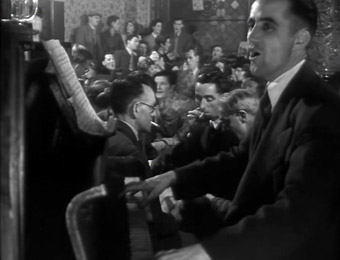
If that all sounds too good to be true, Come Saturday immediately warns us that these were quietly jingoistic government propaganda films, interlaced with a thread of reactionary sentimentality concerning what the nation was. Exaggeration of virtue is to be expected here then and, anyway, the generations that had just helped defeat fascism can be forgiven a degree of self-satisfaction. Portrait of a People does reflect a reality though: the sense that people liked and respected one another more then than we do now. So, it is all the more surprising that there is little mention of Britain's finest hour, the Second World War, the period when the nation was at one as never before or since. George Orwell, as ever, put it best: ". . . because patriotism is all but universal and not even the rich are uninfluenced by it, there can come moments when the whole nation suddenly swings together and does the same thing, like a herd of cattle facing a wolf." Adversity bred unity and drew out the best in the British. Why the war heads the long list of absences in Portrait of a People is, therefore, one of the collection's many mysteries; perhaps it was felt that the wounds were still too raw, more likely, that cinema and, subsequently, television did the job of reminding people of the war just fine.
These films offer valuable insight into the wish-fulfilment fantasies and phobias of those who commissioned them, thus assisting contemporary viewers interested in taking stock of society. But they are equally interesting for what they leave out. Among the pleasures of watching them is that of filling in the gaps. While portraying a romanticised version of nationhood, they also map out a particular period in the ongoing search for a binding post-imperial identity. How, we ask ourselves as we watch, did we get from there to here? Brigadier-General Reginald Dyer unwittingly signalled that the end was nigh for the 'Great Game' of empire when, on 13 April 1919, he ordered British troops to open fire on peaceful protesters at Amritsar. Popular revulsion about the Amritsar Massacre goes some way to explaining why Ghandi received such a generously warm welcome from the textile workers of Lancashire during his visit of 1931, despite the local hardships resulting from the Indian boycott of British cotton. That touching episode in turn partially explains why the Labour Party so enthusiastically supported Indian independence. The Attlee government freed India from British rule in 1947 and, with the 'Jewel in the Crown' gone, it was inevitable that the rest of the empire would be dismantled in due course.
Ever wary of scaring the horses and ever eager to offer reassurance and relieved smiles, Portrait of a People avoids contentious history and troubling contemporary realities. William Gladstone, tottering on the ever-shifting sands of national identity himself at the height of the Irish Home Rule debate, famously said: "The Irish never forget and English never remember." It is regrettable that neither the featured filmmakers nor those who gave the orders at the COI possessed Gladstone's honesty. If there is a dishonesty of omission in these films they nevertheless offer, albeit accidentally, an overview of the perspectives generated during the panicked scramble for ideological reorientation. As Tony Dykes says in the booklet accompanying this BFI release: "The hand of the spin doctor is undeniably present and the sales pitch is clear: 'we may have been your colonial masters in the past but look at what we've given the world and look at what we still have to offer'. In essence, 'we're not so bad, are we'?"
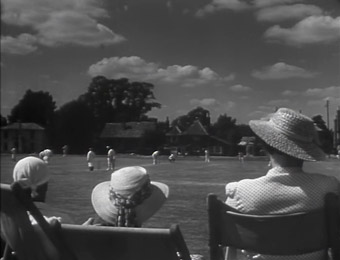
The absence of unpleasant facts and dirty secrets in the collection is unsurprising, and the absence of any mention of the North of Ireland is understandable in that context. The absence of Scotland, though, is as puzzling as it is revealing. It is beyond the scope of this review to attempt analysis of the complex relationship between English and British models of nationalism, but it must be said that, with a couple of honourable exceptions, the people portrayed in this collection are English not British, and most definitely not Celtic. Although the collection arrives stamped Made in Britain, the films are actually, with the curious exception of Moslems in Britain – Cardiff (1961), as white and as English as, say, George Orwell. The titles of three of the films reflect the general tone of the collection: An English Village (1956), Oxford (1958) and Dateline Britain: Look at London (1958). The national poet celebrated in Poet's Eye (1964) is, of course, Shakespeare. There is no room here either for Burns and Dylan Thomas, or for dissenting English geniuses like Auden, Marlowe, Milton and Shelley.
The Celts and the working class were, of course, largely absent from narrative cinema until the late 50s, although allowed on screen as safely comic turns in the George Formby, Gracie Fields films of the 30s and the subtly subversive Ealing comedies of the 40s. There were expectations that proved the rule, but even there crime replaced comedy as a precondition for admission – as in Robert Hamer's It Always Rains on Sunday (1947) and Jules Dassin's Night and the City (1950). Take away John Ford's How Green is My Valley (1941), Powell & Pressburger's I Know Where I'm Going (1945) and Emily Williams & Russell Lloyd's The Last Days of Dolwyn (1949) and there isn't much of Celtic Britain to see. Fortunately, the documentary movement began filming the working class under the auspices of the Empire Marketing Board and, later, the GPO Film Unit. Even with this patchy pre-history, the lack of even passing reference to Scotland in Portrait of a People is startling. It feels especially shocking given that the collection appears in the wake of the SNP's unexpected, unprecedented success in the May local elections. That political victory raised serious questions about the longevity of the United Kingdom and edged us closer to the independent Scotland prophesied by Tom Nairns when he said: "Any day now the wolves will break into the drawing room, and it won't be the cucumber sandwiches they're after!"
John Major strikes me as a man partial to a cucumber sandwich. His politics may be iffy but he's a likeable chap with many of the virtues and few of the vices associated with the English gentleman. When he evoked a 'Britain' characterised by cricket grounds, warm beer, green suburbs, dog lovers, pool fillers (!) and old maids on bikes, he was obviously thinking about Home Counties England. Such restrictive notions of nation, though addressed in that instance to a meeting of the Conservative Group for Europe, are characteristic of a Little Englander mindset much in evidence in Portrait of a People. The definitions of national identity here are as narrow as Major's and the use of quotation equally partial, particularly in Anthony Pélissier's riveting film, Portrait of a People – Impressions of Britain (1970). Like Major, Pélissier had the temerity to draw on Orwell's 1941 monograph The Lion and the Unicorn: Socialism and the English Genius, the most influential, important essay on English national identity ever written. We can assume that Major and Pélissier dipped into dictionaries of quotation. The essay would have made uncomfortable reading for them had they bothered, for this combative argument for another English revolution is also a no-ring-no-ref-no rules, bare knuckle attack on the ruling class – and the bell has not sounded yet.
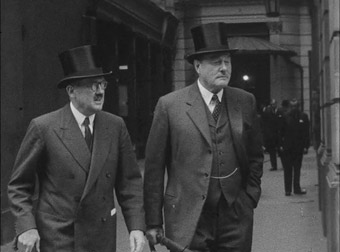
That safe phrase extracted from Orwell's essay was more inclusive, if equally English and patrician, than Major suggests. Orwell actually wrote: "The clatter of clogs in the Lancashire mill towns, the to-and-fro of the lorries on the Great North Road, the queues outside the Labour Exchanges, the rattle of pin-tables in the Soho pubs, the old maids biking to Holy Communion through the mists of the autumn mornings – all these are fragments, but characteristic fragments, of the English scene." Ah, England – the clatter of discarded beer cans on littered pavements, the traffic jams and fatal accidents, the inequality and child poverty, the binge drinking in bars housed in former churches, the defaced graves in cemeteries frequented by doggers, drug users and drunks. Or am I being too harsh?
There is no certainly no place for the unemployed, unhinged hedonists or the abandoned in the sanitised, Southernised account of England presented in this collection. Cameras linger often and long over the lowland English countryside with hardly a cairn or crag in sight. In Looking at Britain – National Parks (1961) we do tramp the rugged hills of Snowdonia and the rough moorland of Exmoor, but the films usually remain within striking distance of London, even when visiting the coast. Given that British imperial might was built on naval supremacy, and given that we were a nation of traders and explorers, there is surprisingly little said or seen of our maritime traditions. As the late, great Jessica Mitford said, "The English are simply besotted with the sea. It's all around them; they're a sea people." Well, by the time these films were made, that connection to the sea expressed itself in a fondness for boats. In England class inequality is seldom far away and it even seeps into these films. In Come Saturday (1946), an indulgent survey of the English at play, we see the middle class are at play on their yachts off the coast, the working class are playing with their toy yachts in park paddling pools. We never see brassy working class Blackpool, but we do visit pretty, petit-bourgeois Lynmouth. The bawdy, breezy seaside resorts were clearly too crude for the genteel gents of the COI. They might have rethought that omission had they sensed the soporific effects of seaside resorts, those alluded to by Patrick Keiller, in Robinson in Space, when he said that Blackpool was all that stood between England and revolution.
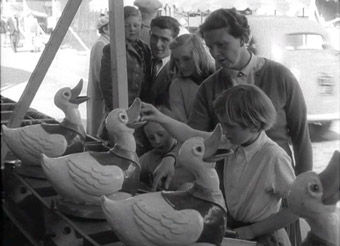
We do, at least, venture North in one film – to the West Riding of Yorkshire and Huddersfield, in Industrial Town (1962). Norman Hemsley's film provides one of the collection's few ventures into North Country landscapes, but the general emphasis in the collection is on the South not the North, on recreation not industry. The trade unions are ignored in Industrial Town just as they are in the other films. If the wiping of millions of trade unionists and Scots from the cinematic record is appalling, it is at least logical in the context of backward Whitehall thinking, but there are other, even more bewildering absences. Given that these films aimed to sell Britain, it is amazing that nothing is made either of the much-vaunted British sense of humour or of three of our most successful exports (besides trade unionism) – cinema, football and pop culture. There is a fleeting glimpse of Julie Christie on the set of Far from the Madding Crowd in 1967, a passing glance at a Huddersfield Town home game and a quick flash of the FA Cup Final of 1969, but, interestingly, no mention of the World Cup victory of 1966, and next to none of pop. We wouldn't expect reference to the lefties of the folk movement and 60s counter culture but . . . nothing – not an Animal, Beatle, Kink, Stone or Yardbird to be seen or heard. The only nods to pop culture come when it is attacked, as it is in The Poet's Eye, or mocked, as it is in the opening sequence of Pélissier's Portrait of a People, in which gawky middle class kids hop around to easy-listening novelty hit Winchester Cathedral.
Pop could and should have featured in the superb closing films of the collection: Speaking of Britain (1967), Opus (1967) and Portrait of a People (1970). The BFI had, to be fair, hoped to release Opus as director Don Levy intended, with The Beatles' Drive My Car included on the soundtrack, but rights problems prevented that. Despite this reservation, and although all the films in the collection are interesting in their own way, the final four films feel fresher and less constrained than the other films. That may be partly because the collection bursts into colour with The Poet's Eye. Be that as it may, these four films take the collection to higher heights. Opus, Levy's inventive, kaleidoscopic montage of avant-garde British design and culture, stands out even in this company. Like Speaking of Britain it captures the daring and fizz of the late 60s brilliantly. Again, it is a mystery why Levy, in common with the rest of the featured filmmakers, largely set popular culture aside as unworthy of attention, thereby passing up the opportunity to show us an England we might relate to completely. Instead, we are offered endless images of folk rambling or cycling in the countryside, at classical concerts and cricket matches, playing bowls, skittles, golf, tennis and table tennis, folk fishing, gardening, ice-skating, basket-weaving and, inevitably, drinking beer and tea, mainly tea, lots of tea, urns of the stuff.
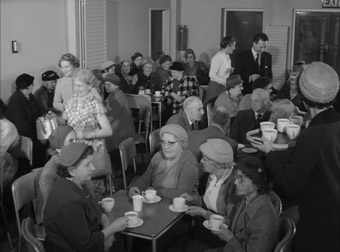
Those are blameless forms of relaxation, pleasant enough in themselves, but, even allowing for the fact that many of those pastimes were more popular in Britain then than now, they do not paint the whole picture. The urge to quote Orwell on earthier eluded realities is irresistible: "The genuinely popular culture of England is something that goes on beneath the surface, unofficially, and more or less frowned on by the authorities. One thing one notices if one looks directly at the common people, especially in the big towns, is that they are not at all puritanical. They are inveterate gamblers, drink as much beer as their wages will permit, are devoted to bawdy jokes, and use probably the foulest language in the world."
Orwell felt that, even after the stock exchange was pulled down in the revolution he hoped for, England would remain largely unchanged – "an everlasting animal, stretching into the future and the past, and, like all living things, having the power to change out of recognition and yet remain the same." An enemy of injustice, Orwell would surely, if he were here today, be disgusted to see entrenched class privilege intact in the early 21st Century, with both the country and its capital still run by Old Etonians like himself – disgusted but not necessarily surprised or despondent. As he said, "The nation is bound together by an invisible chain. At any normal time the ruling class will rob, mismanage, sabotage, lead us into the muck; but let popular opinion really make itself heard, let them get a tug from below that they cannot avoid feeling, and it is difficult for them not to respond." He would have despised the banks and the Murdochs but I doubt he would have despised us. He died in 1950 before most of the films in this collection were made, so we can only guess what he would have made of us; my guess is he would find us more aggressive, selfish and greedy than his peers, but also refreshingly less reverent and docile. He would certainly have relished the end of empire and probably would've chuckled at Doris Lessing's joke.
My many gripes about the lacunae and elisions of Portrait of a People are prompted partly by feelings of sadness, anger and disappointment. Orwell defined England as "a family with the wrong members in control." Well, most of the family is airbrushed out of this partial picture of national life. Meanwhile, the family furniture and silver was long since flogged off to the lowest bidder and the current cuts will doubtless do for some of the last remaining jewels in the crown of our culture. Take two examples: the British Federation of Film Societies recently lost the bulk of its funding and is struggling to survive, while the government recently announced that the COI itself will be shut down. Many of the COI films in this collection were delivered to home audiences by an extensive fleet of mobile film units, for screening through outlets such as film clubs. Now film societies may not be a single solution to cinema's decline as a popular medium, one capable of contributing to the free flow of information and ideas, but they did and do provide an affordable alternative channel for films denied access to the multiplexes. And the COI may have been compromised and often jingoistic, but it did, at its best, produce essential public information films that improved our collective health and behaviour.
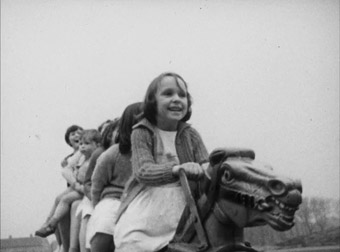
Does the government believe that standards of public behaviour and of knowledge are now so exemplary that there is no longer need for COI films like Cough and Sneezes (1945), Clunk-Click (1973), Keep Britain Tidy (1974) or Climate Change – Tomorrow's Climate, Today's Challenge (2005)?* Of course it doesn't. If it did, it wouldn't have launched the Change4Life public information campaign to address the tick-tocking time bomb of obesity, nor handed the multi-million pound campaign to Messrs M & C Saatchi for completion, nor, now, be asking companies like Flora and PepsiCo to do the job for them.
The BFI's collectable and commendable COI series complements another magnificent BFI project, its three-volume release of films from the GPO Film Unit. We owe the BFI as huge a debt of gratitude for making such films available as that which the filmmakers of the COI owed to their predecessors at the GPO Film Unit in particular and the documentary movement in general. The COI traced its line of descent through a succession of government propaganda departments: the First World War Ministry of Information (1918-19), the Empire Marketing Board (1926-1933), the GPO Film Unit (1933-1940), the Crown Film Unit (1940-1952), and the resurrected Ministry of Information of the Second World War (1940-1945), model for the Ministry of Truth in Orwell's 1984.
There are traces of that tradition and of Griersonian aesthetics in Portrait of a People – most notably in Come Saturday, which was obviously modelled on Humphrey Jennings' Spare Time (1939) – but they are traces only. Jennings himself was greatly influenced by The Lion and the Unicorn and the essay informs his final film, Family Portrait (1950), a commission for the Festival of Britain. Again, one can only shake one's head in sorrow that the COI denied filmmakers the chance to continue where the documentary movement left off after Grierson's departure for Canada and Jennings' death, and wince at another opportunity wasted. Britain can proudly boast of possessing one of the world's most extensive moving image archives (the BFI National Archive), one of the world's great film organizations (the BFI), and world-class excellence in the field of non-fiction filmmaking. But one look at the documentary achievements of Grierson's creation, the Canada's National Film Board, shows us what might have been and what a gawping historical opportunity this country flunked.
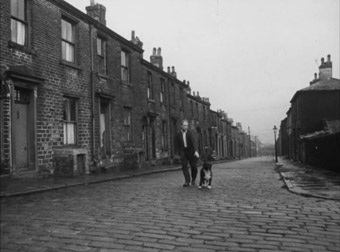
In The Art and Politics of Film (2000), John Orr argued that, "Film is at its most effective when it challenges national identity, when, far from confirming it, it points out our contradictions and frailties of perception, when it unveils discord or division." Clearly the films collected in Portrait of a People confirmed rather than challenged a conventional, reactionary version of national identity, but they still have much to tell us about ourselves and are, as such, interesting and important as social history. This superb collection of entertaining and revealing films reminds us how much we have changed and how little. It charts the changes of the post-war war period and serves as a useful guide to who 'they' thought 'we' were.
DISC 1
1. Come Saturday [1949]
The collection opens with an Anglo-Scottish Films production about the English at play. It is half past twelve on a summer Saturday. Workers down tools or cover up typewriters and head to the countryside or coast for fun. The tone of camaraderie is established from the off, as chummy, plummy Ralph Richardson draws us together by quoting from the Duc de Sully's memoirs. Richardson says: "Somebody said the English take their pleasures sadly, but he was a Frenchman, he didn't really know . . . They take it gladly . . . the only order of the day is: go as you please and do what you like." After setting the scene Richardson steps back and allows the images to speak. The film unfolds as a montage of healthy exercise and healthy people. Workers board trains at Victoria station. The sun shines on the waiting English countryside. There is hardly a cloud in the sky. A cycle club sweeps up a country land. Polite applause ripples across a village green as a wicket falls. Boys splash about in the local lido. Yachts bob on the water.
Come Saturday is imbued with the collective, we're-all-in-this-together spirit of the war years, and 'we' are a lovely bunch. The peace of an angler is disturbed, first by a couple of working class lads in a rowing boat, then by a passing pleasure boat full of cockneys singing "My Old Man." We are invited to relate to the boys and the partying cockneys and to smile ruefully at the grumpy lone individual. The implied question is: why doesn't he join in, does he think he's better than us? Throughout the day we see people at play, together, but as the sun sinks behind a rural church spire everybody heads home. Back in the city, a pub sing-a-long ends, dancers sing Auld Lang Syne and the night shift clocks on. Ralph Richardson reappears to wind the film down and tuck us all up in bed: "North and South, town and country, they're turning out the lights. To all of them, good night."
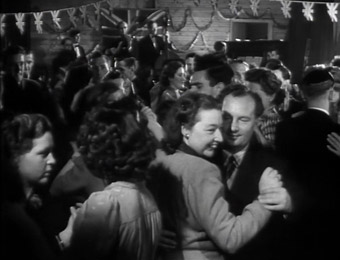
2. Local Newspaper [1952]
This film presents a day in the life of a family-owned local paper, the Newberry Weekly News, and that of the community the paper has served since it was founded in 1867. In its first editorial the paper's founder W.T. Turner declared: "It will be our endeavour to refrain from advocating the views of any party or sect, but rather to give an opportunity for all sides to be heard." Unlike the vast majority of local newspapers the News remains independent and true to its founding principle. That integrity may explain the paper's continuing popularity and the respect afforded it locally. By the time this film was made it was run by Turner's son. "Mr Hugh Turner – he's a big friendly man . . . he knows his readers and they know him, as a man who will only publish what he believes to be the truth."
Oh no, there's been an accident! Relax, Mr Turner and his team are on the case. "No matter how rich or important the offender, the facts will be given to the public." Mr Turner wants action. He wants traffic lights. The traffic lights proposal is voted down at a Council meeting. Boo! That won't stop Tubby Turner. Hip hip . . . "He will write another strong article about the number of accidents at this corner and will publish letters showing the views of his readers, and in the end the weight of public opinion will produce action." Hurray! The local newspaper as was is presented, justifiably, as another institution to be proud of, "an essential and democratic part of everyday life in Britain."
3. An English Village [1956]
The Colonial Office commissioned Anvil Films to produce this film about community cohesion and the 'timelessness' of English institutions. An English village is more than "a mere cluster of dwellings clustered around a church. It is, first and foremost, a collection of people, people who live and work and play together." It is "a symbol of neighbourliness . . . most stable of all the institutions in England's long history." The village is Harting on the Sussex downs. The Parish Council is a metaphor within a metaphor; it stands for engagement with the democratic process. "These people have learned the art of living together as a community." We nip into The White Hart for a swift one. "A cheery, companionable place this, where talk of every kind flows freely and easily." The church bells chime. Apparently there are few villages in England that don't possess a bell ringing team. The men work the land. The women weave baskets. The children are cherished. "The school takes care of their bodies as well as their minds. Every day, for instance, each child receives a bottle of milk."
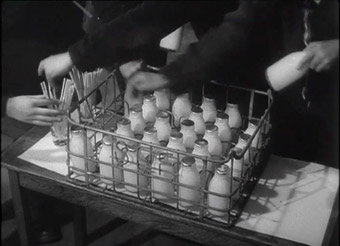
4. Oxford [1958]
The COI commissioned Greenpark Films to produce this promotional film about the great university. It is no accident that the camerawork and editing is superb; cameraman Fred Gamage and editor Jack Ellitt cut their teeth under Grierson in the pre-war documentary movement. The rooftop tracking shots of ancient Oxford's statuary and steeples, in particular, are brilliantly composed. The view it offers the less bright and privileged of us into the inner sanctum of educational excellence is fascinating. The tone is often too pompous for contemporary taste but it is hard to disagree with the claim that 'Oxford's history is inseparably bound up with the history of the nation." When the narrator says that, "Oxford has always been more than a place where young people are taught" one is tempted to add that it has always been a factory of class power. With the exception of Moslems in Britain – Cardiff (1961) this is the film within the collection most modern in its ethnic diversity. Sadly that recognition of diversity flowed from the film's brief to sell the virtues of the university to Commonwealth audiences not from a desire to portray a people in the round.
5. Look at London [1958]
In the late 50s the COI began to produce more films for television; this one was intended for broadcast in Australia and Canada to improve trade and tourism. Canadian raconteur and radio journalist Bernard Braden's personal exploration of London shows us a city of buttoned-up citizens on the cusp of social and stylistic change. It is wonderful watching the Londoners and London of that time; again, everything has changed but remained the same. The film delivers several of the few intentionally funny moments in the collection: when he notes: "Eight and a half million, that's a lot of people, and if you ever try walking down Oxford Street while the shops are open you'll find them all coming from the opposite direction." The droll scene in which Braden tries on an English suit with the unsmiling assistance of an inscrutably servile tailor is a hoot ("Are you kidding Jack"?). The scenes shot at Speaker's Corner are equally riveting. Braden had a brilliantly effective laid-back interviewing style. He certainly brings the best out of a group of Westminster schoolkids, and out of an irrepressible Harry Seacombe. Here's a city possessed of 500 parks, 400 cinemas, 70 live theatres, 50 nightclubs . . . "plus 50 that aren't mentioned in any guide book." This is a cheeky, charming wee gem of a film.
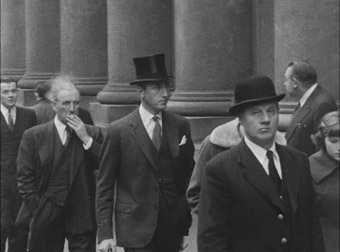
6. National Parks [1961]
After Braden's droll, debonair style, this Kinocraft produced informational film intended for overseas audiences was sure to feel dry – and it sure feels dry Jack. It is the least substantial film in the collection. As the camera sweeps across the chimneystacks of a crowded urban landscape, the narrator explains that parliament had recognised the need "to keep unspoiled the beauty and peace of the countryside so that people could escape from the noise and smoke of the city." Thereafter the camera gallivants about Snowdonia and Exmoor to the accompaniment of MJQ-lite jaunty, jazz vibes. "Young people in particular like to spend their holidays roving through this open countryside, on foot or on their bicycles." No need for the Tufty Club here then. But two young campers, Billy and Tommy, and by implication those watching the film, do need a gentle reminder to leave the country as they found it, "tidy and clear of litter."
DISC 2
7. Moslems in Britain – Cardiff [1961]
This is the wild card in the pack of this collection. Commissioned to encourage immigration from the Arab world during a time of full employment and labour shortages, this extraordinary film is typical of the double-documentary nature of these films. They document the establishment ideas of their day while incidentally documenting real lives and places. In Arabic with English subtitles, the film invites its audiences to join us on our prosperous, tolerant, welcoming island. Presenter Gamal Kinnay drives down to Cardiff from London in his Ford Anglia to interview fellow Arab émigrés and wax lyrically about the Welsh capital. Sheikh Saeed, a spray-painter at a company called Gulf Radiators, had no problems finding work. Hussein Mohamed Ali, one of two welders – "friends and brothers in Islam' – Kinnay interviews, didn't either. He says: "The pay is good, everything is good." Another remarkable interview includes one with the Lady Mayoress of Cardiff: resplendent in her chain of office and petalled hat, tells Kinnay that integration has been seamless. The local Arabs, she says, are "an integral part of the city. . . they are accepted as friends among the rest of the community."
Many of those interviewed have married local women. One beautiful Welsh woman, a mother of 10 children who also runs the Cairo Café in the Arab quarter, tells Kinnay, in fluent Arabic, how content she is. These interviewees are all credible witnesses to a genuine sense of community cohesion and pride. Kinnay himself, however, we take with a pinch of salt when he says: "I would not be exaggerating, Ladies and Gentlemen, if I say that the location of Cardiff's official buildings and institutions is one of the most beautiful I have seen in Europe so far." Where he has travelled previously he does not say, but one 'unofficial' building he visits, the city's Noor Ul Islam mosque in Butetown, is certainly beautiful to those who worship there. Luftwaffe bombers destroyed the original mosque on the site during the Blitz, but it was rebuilt with the help of the Colonial Office and the British Council and reopened in 1943.
8. Industrial Town [1962]
Huddersfield, birthplace of Harold Wilson, is the only film in the collection to venture North. The narrator in Norman Hemsley's film opens by describing the beautiful and solid West Riding town: "It's neither old and charming, nor bright and new, for this is an industrial town . . . a town where time is marked by the sound of the factory hooter." Huddersfield, internationally renowned as a centre of excellence in light engineering and textiles, is home to "a closely knit community." In the jolly-hockey-sticks, patronising tone typical of the film, the narrator explains: "Oh yes, the people of Huddersfield are shrewd, hard-working and fiercely independent, but they have a natural gaiety and a zest for pleasure." The film, true to its title, trots through the town's industrial history, then nips in and out of a textile factory and an engineering plant. It betrays a discernible lack of enthusiasm about working class life though, a nervousness even. The film seems to sigh with relief when the town clocks off in the evening. Now it can focus on leisure pursuits and leave that weird work stuff behind.
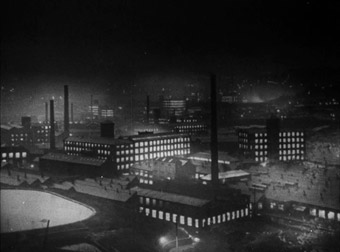
We learn that "Huddersfield is not a big, sprawling town like London" and that "in less than half an hour a worker can walk again on home ground." Soon the worker is safely back in "the quiet home of his private world of suburban homes and gardens." That last comment might puzzle the alert viewer. Given that the camera frequently pans across hillsides black with neat rows of terraced two-up-two-downs, who heads home to them then? A quick bite to eat, then, ". . . perhaps a fast set of tennis, a quiet game of bowls, or a round of golf." We doubt that these are the same people at the Huddersfield Town match or who boast of sons "Born with a cricket bat in one hand and a copy of Handel's Messiah in the other." Huddersfield, to be fair, is presented as a progressive town, one with dynamic, if not ancient educational institutions, a town where the energy of youth combines with the wisdom of old age to pave the way for the bright future.
9. John Turner MP [1962]
This pedestrian account of the busy life of a member of parliament was obviously commissioned to trumpet the virtues of the "Mother of all Parliaments." The most notable aspect of this film is that John Turner MP was not a real MP, so we are actually watching an actor playing a fictional MP for a fictional constituency. Now I can understand why the COI might have shied away from the idea of featuring a real parliamentarian. As Michael Brooke points out in his booklet liner notes on the film, that would have laid the COI open to accusations of political bias. If that were the thinking behind the decision, it then becomes all the more senseless and curious that the MP depicted in the film represents a Middle-England market town and supplements his 'modest' parliamentary salary by working as a journalist for the Daily Telegraph. It hardly needs saying that he can only be a Tory. England is, after all, a country where the newspaper a person reads generally amounts to a declaration of political or tribal loyalty. It's what Christopher Hitchins had in mind when he spoke of "The herd of independent minds," and what T.S. Eliot alluded to when he said: "They know what they are to feel and what to think/They know it with their morning printer's ink."
That ludicrous blunder or calculating sleight of hand, call it what you will, has a positive outcome for the film and for us. 'Turner' walks down Fleet Street towards the camera, before dipping into the famous Telegraph offices immortalised by Evelyn Waugh in his comic and satirical masterpiece Scoop. We are then, amazingly, taken on a guided tour of a working national in the days of hot metal typesetting, when Wapping was just a decaying docks area. Here is another example of this collection's double-documentary, win-win strengths. It may be a mere coincidence that the majestic old Telegraph building at 133 Fleet Street is now home to the investment bank Goldman Sachs but accidents of history have a way of revealing more than arid fact. Other, more concrete coincidences lead me to guess that 'John Turner' was modelled on the real Hugh Turner of Local Newspaper. Setting the coincidences of the surname and the newspaper settings aside, there are certain similarities to the two Turners. There is also is a sequence in this film too built around an accident black spot, with the mock Turner taking the problem on as a personal crusade and saving the day, though now without the help of public opinion.
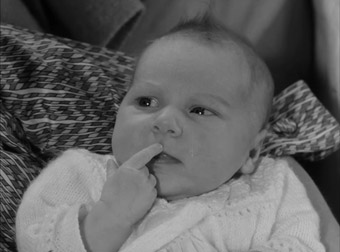
10. The Poet's Eye [1964]
On the occasion of Shakespeare's quartercentenary, the COI seized the moment and commissioned this celebration of the Bard's life and work. This is the first colour film in the collection, so it arrives with considerable visual force. It bursts from the screen like that unforgettable moment in the The Bill Douglas Trilogy when Lassie appears on screen, in colour, in an otherwise black and white film. The Poet's Eye It is an unusual film in that it combines commentary, stock images and quotes from Shakespeare's work to paint of a picture of contemporary Britain. Presented and narrated by Shakespearean actor Stephen Murray, the film is to be commended for its daring and invention. While literary citation and adaptation all too often kill the source material stone dead, this film presents the beauty of Shakespeare's language in a context that enlivens it. In addition, if the collection's many glaring absences betray the prejudices of their day, the absence of men in tights is entirely welcome. Stephen Murray opens the film with an observation that serves as a useful metaphor for COI myopia: "From the images used most often by a writer, we can get a fair idea of what excited and delighted, or even angered or disgusted him.' That telling phrase can equally well be applied to this film and I'd like to single out one execrable episode in this otherwise excellent film to illustrate my point.
As I've said above, pop is, regrettably, all but ignored in the final four films. It isn't ignored here. More's the pity. In a rare moment of connection to the predilections of young Britain the film features footage of a live gig and a dance floor full of kids. The band are inept, but it's unlikely that director Gordon Hales would appreciate the difference between them and, say, that new outfit from Liverpool that everybody would've been talking about. One might as well compare Mozart to Mantovani or Shostakovich to the James Last Orchestra. Apparently Shakespeare, the great populist, disliked the "graceless antics of the jig." As the screen fills with clean-cut dancers, the commentary damns them by association. Shakespeare, we are told, used the word "jig," "to mock the posturings of fops like Aguecheek and Armado." Murray's voice then turns snarly and sneering as he quotes from Love's Labour's Lost: "Jig off a tune at the tongue's end, canary it with your feet, humour it with turning up your eyelids, sigh a note and sing a note, sometimes through the nose as if you snuffed out love by smelling love." Shakespeare is deployed to condemn "violent noise," for him "the earth was the centre of an harmonious universe, as monarchy was the pivot of a well ordered state." That most well ordered states dispensed with monarchs many moons ago isn't allowed to get in the way of a nice national story. What surprises lay in store for the author of that commentary!
11. Speaking of Britain [1967]
The collection enters the modern era with this superb documentary celebrating Britain's capacity to accommodate the ancient and the new. It feels as if the film takes it lead from the era-defining 'technology' speech in which Harold Wilson told the 1963 Labour Party conference that, "The Britain that is going to be forged in the white heat of this revolution will be no place for restrictive practices or for outdated methods on either side of industry." The class war, he seemed to declare, is over and it was a no-score draw. The closed shop may have followed free collective bargaining into the history books, but the changes brought in by technology have changed the way we live. This film interviews Britons about the new Britain.
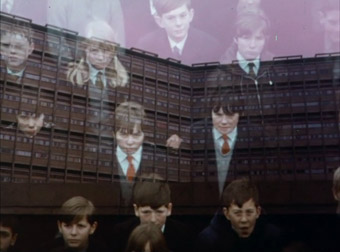
Annoyingly, it is hard to decide whether those interviewed were allowed to speak in their own voices. At times it is clear that we're hearing actors, at others we're not so sure. At rate they are a wonderful bunch. They are a lucky, contented bunch too, because you sense that these individuals are pushing forward as one, much as those in Come Saturday did.
The emphasis is on science, industry and change but we're also back on the ice-rink, back for another helping of Handel's Messiah, and back with the Duc de Sully – quoted again by Patrick Moore, or someone doing an excellent imitation of him. In architecture, astronomy, marine biology, sociology, education and engineering – wherever the film takes us, change is in the air. Most fascinating of all, we meet young architects in Sheffield and take a tour of the city's Brutalist Park Hill Estate. Long before the idea of 'cities in the sky' came crashing down to earth the estate looks like a decent place to live. Somebody says: "Somebody said quite recently that Britain is in the hands of revolutionaries. You only have to look around you to see how true this is. There's more analysis, more enquiry going on than ever before. People are at grips with new ideas beating out a new society. There's never been such a feeling of change."
12. Opus [1967]
Commissioned for screening in the British Pavilion for Expo 67 in Montreal, Don Levy's dynamic film, a perfect fusion of form and content, is the most daring in the collection. These exclusively visual "Impressions of British Art and Culture" beat the dust from well-worn drapes, sweep the cobwebs from stained glass windows, then fling them open to let the fresh air of change rush in. From the discordant notes that accompany the opening credits onwards it is plain that the intention, if not the brief, was to set aside conventional definitions of national identity and announce a new force in the world – a daring, dynamic, experimental, energetic, inventive land. It feels as if the nation was sufficiently self-confident to set aside tired myths and legends, and certain enough that its pop culture was stamped on the world map, to hold those aces up its sleeve.
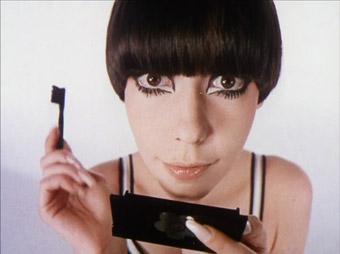
Opus might easily have been called ENGLAND! NOW! Even viewing it through the blasé blinkers of the early 21st Century it looks lively. It amounts to a series of headlines and notes on aspect of Swinging 60s culture. ARCHITECTURE! Centrepoint. Modernism at Moorgate. The Post Office Tower. ART! Bacon. Bridget Riley. Hockney. Henri Moore. CARS! The E-type Jag. The Mini Cooper S. Bond's Aston Martin DB5. FASHION! Peggy Moffitt, fresh from appearances in Blow-Up and Who are You, Polly MaGoo? Twiggy & Co at London Wall. THEATRE! David Warner prowls a darkened stage in Hamlet, filmed before his appearance in Morgan: A Suitable Case for Treatment. Ian Holm and Vivien Merchant spar in Pinter's The Homecoming, limbering up for the film adaptation. It's all dished up in breathless quick-fast time, with close-ups and cross-cuts and zooms. It is also, occasionally, very silly. A bearded beatniky artist apes Pollock, splashing paint around. Best of all though: Glenda Jackson looks stunned by the nonsense unfolding around her in Peter Hall's adaptation of Peter Weiss's The Persecution and Assassination of Jean-Paul Marat as Performed by the Inmates of the Asylum of Charenton Under the Direction of Marquis de Sade. What must Gordon Hale, Anthony Pélissier and the chaps at the COI have made of it?
13. Portrait of a People [1970]
The title film sits comfortably at the end of the collection, not just because it calms us down after the jolt of Opus, but also as it deftly summarizes all that has been said before. Pélissier packs as much in here as Levy does there but the tone is more measured. Words return, in force. Sonorous, solemnly delivered lines from Churchill, Keats, John Stuart Mill, Orwell and Wordsworth come at us as fast as the stock images do. The rhetorical brio ushers back the tried and tested tropes of British national identity, all dressed in familiar imagery: the rugged coast and the gentle countryside, yachts and combine harvesters, financial might and heavy industry. This grand finale insists, again, that Britain is earthed in a solid, illustrious past but sure in its hopes of a brave new future. Beveridge's Five Giants – want, disease, ignorance, squalor and idleness – are telescoped into "freedom from fear" but the icons of 60s technological are all there: BOAC 747s, Concorde, Hovercraft, the Harrier jump jet. Like the collection itself, this film is simultaneously stirring and saddening. Like the collection, too, it describes a people familiar but strange to us, close but distant.
With thirteen films – fourteen if you include the below detailed extra feature – made over a twenty-one year period, the image quality is obviously going to vary a little of the set as a whole. All of the films were shot on what looks 35mm, and have clearly enjoyed differing degrees of care and preservation, resulting in various levels of sharpness, stability (some jitter a little, others are rock solid) and print condition. The weakest has to be Moslems in Britain, whose shifting contrast and sharpness play second fiddle to intermittent rainstorms of dust, scratches and film damage, a testament perhaps to the film's rarity. Others suffer from dust assaults for the first couple of minutes that decrease sometimes markedly as the films progress (as ever with film, its the outer edge of the reels that attract the most dust and dirt). For the most part the contrast levels are nicely balanced, with pleasing grey tones and not too much detail lost to the solid blacks, and the level of detail is often very good. The best material has scrubbed up well, with Oxford, John Turner MP and the colour films Poet's Eye, Opus and Speaking of Britain looking the best. All films are framed in their original aspect ratio of 1.37:1.
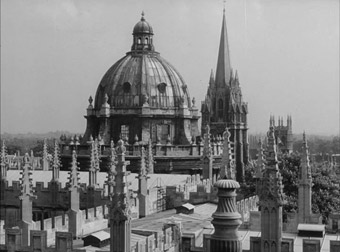
Inevitably the Dolby mono 2.0 soundtracks are sonically a little primitive by today's standards, but are standard fare for their collective age, although there is surprisingly little different between the older and newer films. There is some audible fluff and crackle on some of the tracks, something particularly true of Moslems in Britain, which also boasts a background hum and a few small pops.
English subtitles for the hearing impaired are provided for all films.
Shown by Request [1947]
This bonus film tells us all about the COI's non-theatrical distribution work. It focuses on the Central Film Library at the Imperial Institute (later the Commonwealth Institute) in South Kensington. The CFL distributed free public information films for screening in canteens and churches, town and villages halls, libraries and film clubs. The film will fascinate cinephiles and social historians alike and, if my reaction is anything to go by, it may make you laugh and cry. It so often loses itself in the minutiae of the mechanisms of lending that I found tears of hysterical laughter streaming down my cheeks as the filing process was described in minute detail. I choked back tears though as I watched an excited group of country folk making their way through the summer evening to the village hall for a screening of Ralph Keene's COI documentary Cyprus Is an Island (1946). This lovely scene is replicated weekly throughout Britain today by community cinemas supported by the embattled British Federation of Film Societies. It is a magnificent sight and a great idea that deserves government support.
The COI films themselves were distributed by means of a fleet of CFL mobile film vans. When the vans landed in the lap of the COI (having previously been controlled by the Imperial Institute and the Ministry of Information) the department increased their number to 144. Television did for the fleet but the idea of touring cinemas was picked up by Postmaster General Tony Benn in the 60s. He created a small fleet of seven space age mobile units to take what would now be called 'best practice' films to industry. That later fleet was itself disbanded in the early 70s but one survivor was recently renovated, lovingly and painstakingly, by a couple in Cornwall. Their company, the Vintage Mobile Cinema, now takes films to all corners of the island. The unit is the centrepiece and vehicle for an imminent BBC Two series, The Reel History of Britain, presented by Melvyn Bragg. Bragg tours Britain in the unit, screening archive films to local communities, then teasing out their responses. It is what the COI was all about. It is what community cinema and the BFFS is all about.
Booklet
In addition to Shown by Request, this collection contains a glossy, well-presented booklet full of information, images and ideas. Credits are included for each film and informed individual contributors ( mainly BFI curatorial staff but also excellent freelancers like Michael Brooke) provide well-researched background details and offer erudite snapshot analyses. The views expressed in those film notes are often provocative but that is all to the good as the booklet will stimulate thought and generate debate. The BFI has its flaws and makes some ill-advised decisions, but it is an institution of which we can be justifiably proud. This booklet and this collection of films are typical of the great job they do. The notes provided for screenings at the National Film Theatre (BFI Southbank if you must) always add to the pleasure of the film-going experience and increases one's knowledge of cinema. This booklet does similarly sterling work.
Fourteen fascinating films, nearly 10 hours of viewing, and an informative 26-page booklet, make this BFI release remarkable value for money. The component parts of this extraordinary release combine to tell us more than long shelves of history books could about the country we inhabit and which inhabits us. Portrait of a People amounts to a chronological survey of notions of national identity as they evolved in the post-war period. As such, it makes a valuable documentary contribution to our understanding of social and political history. It show us the people we have become by reminding us of the people we were. These films are often enraging, but they are also enthralling, engaging and wonderfully entertaining. Highly recommended.
|